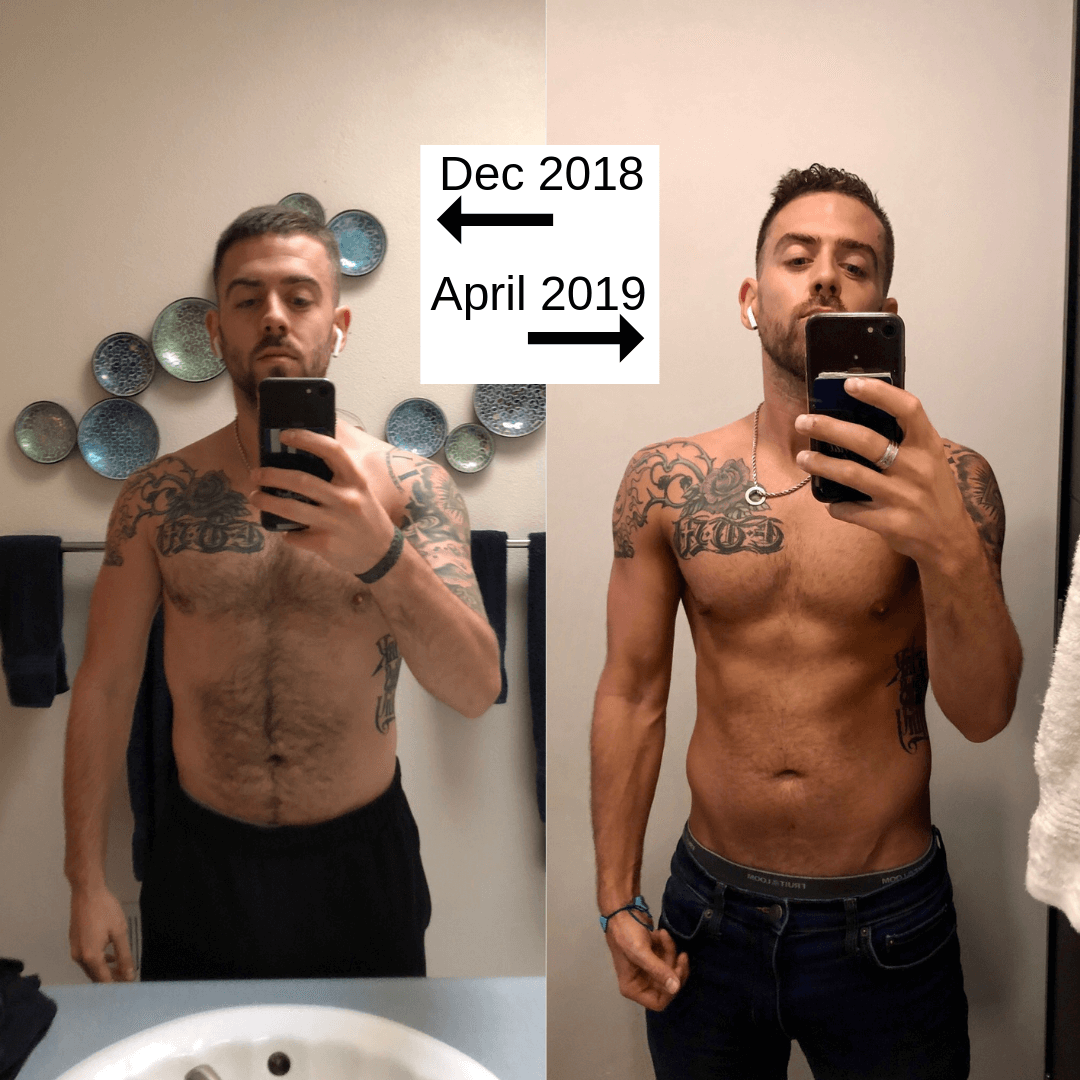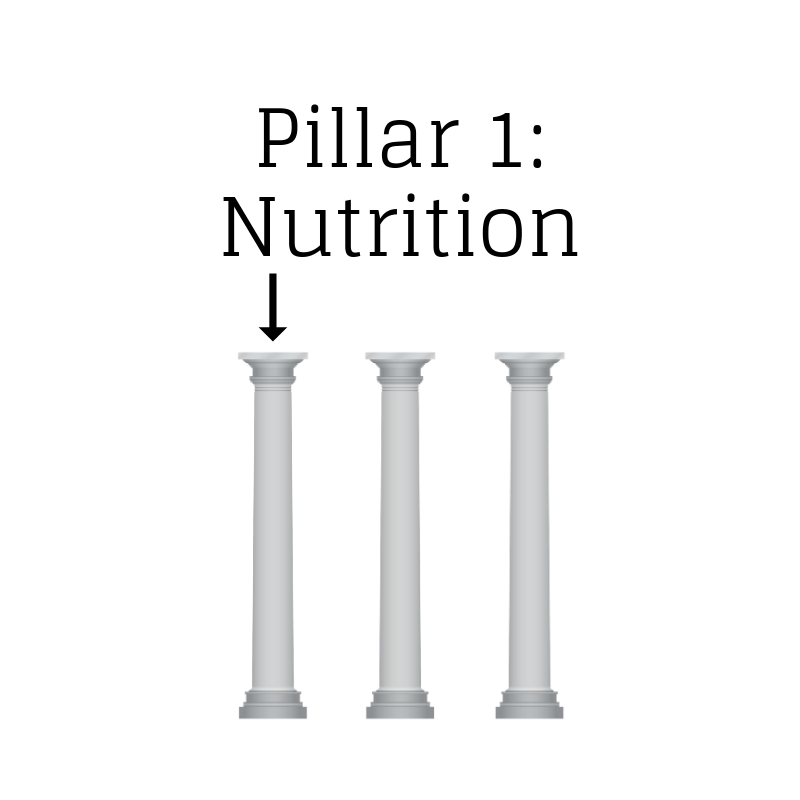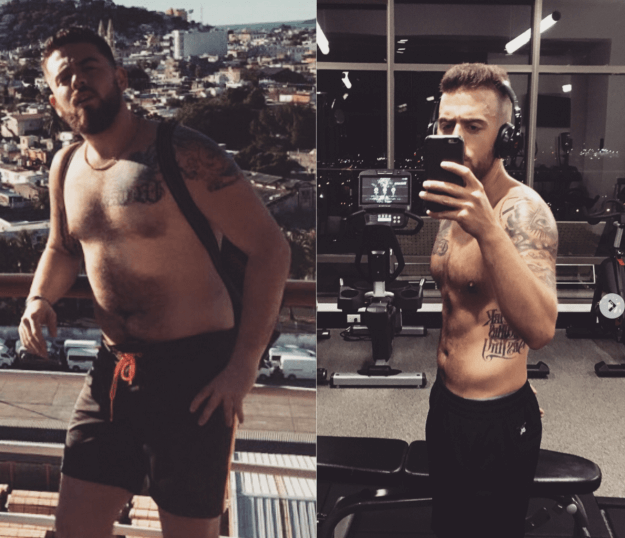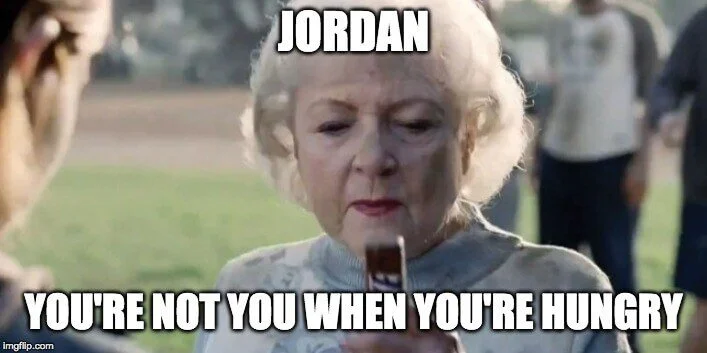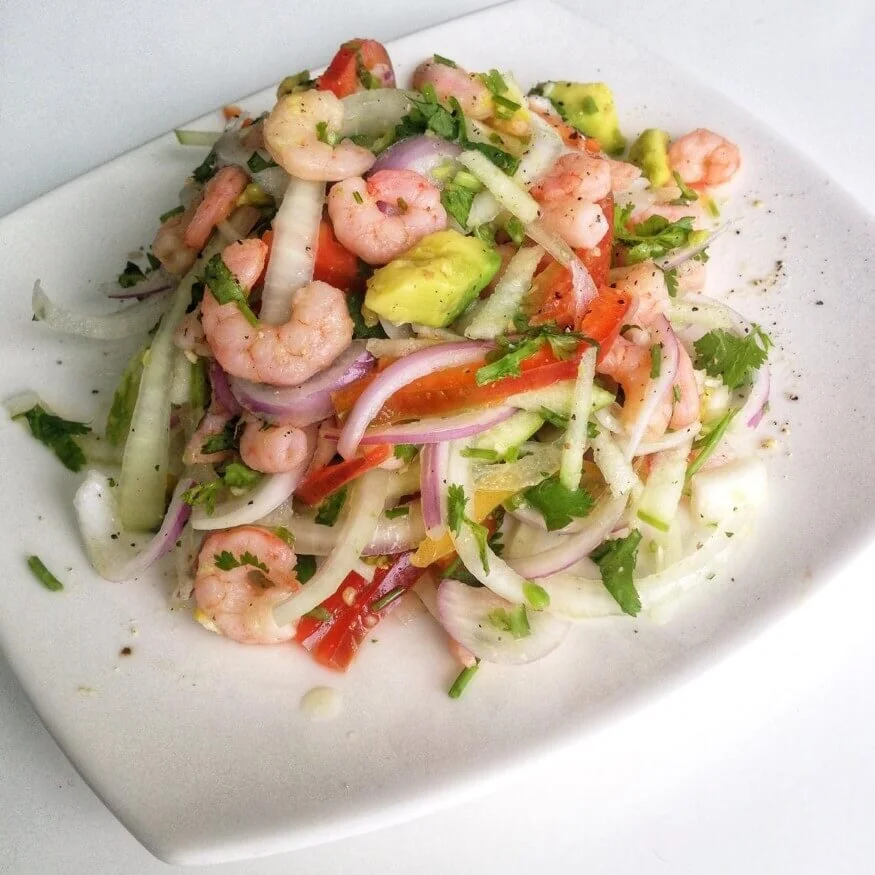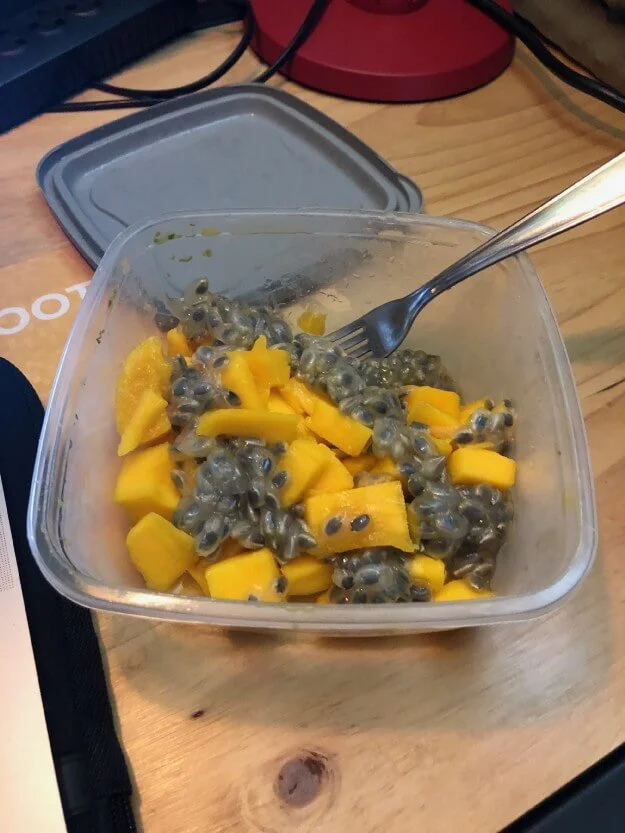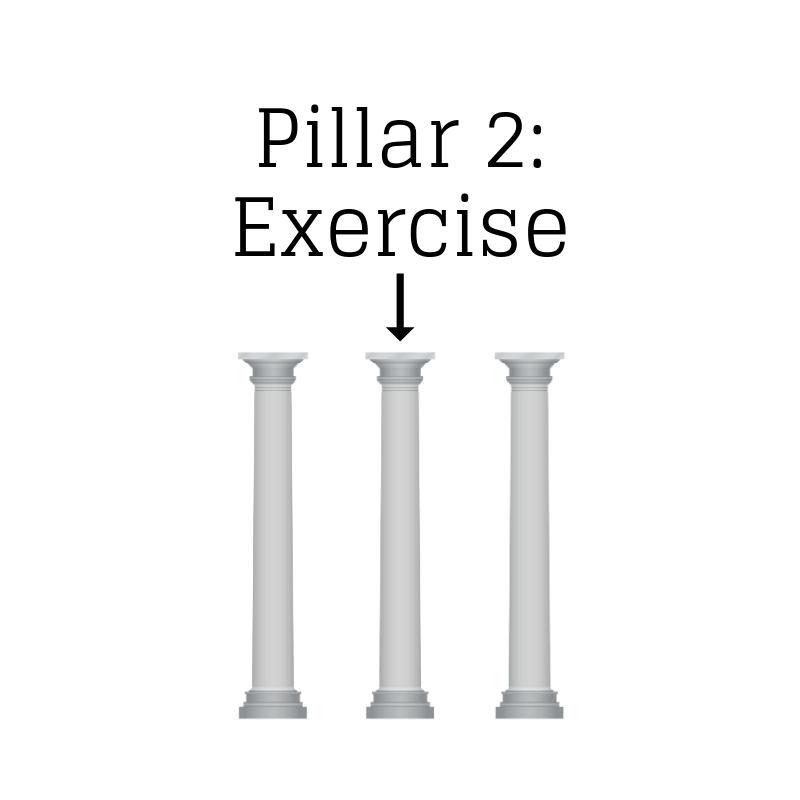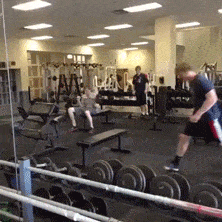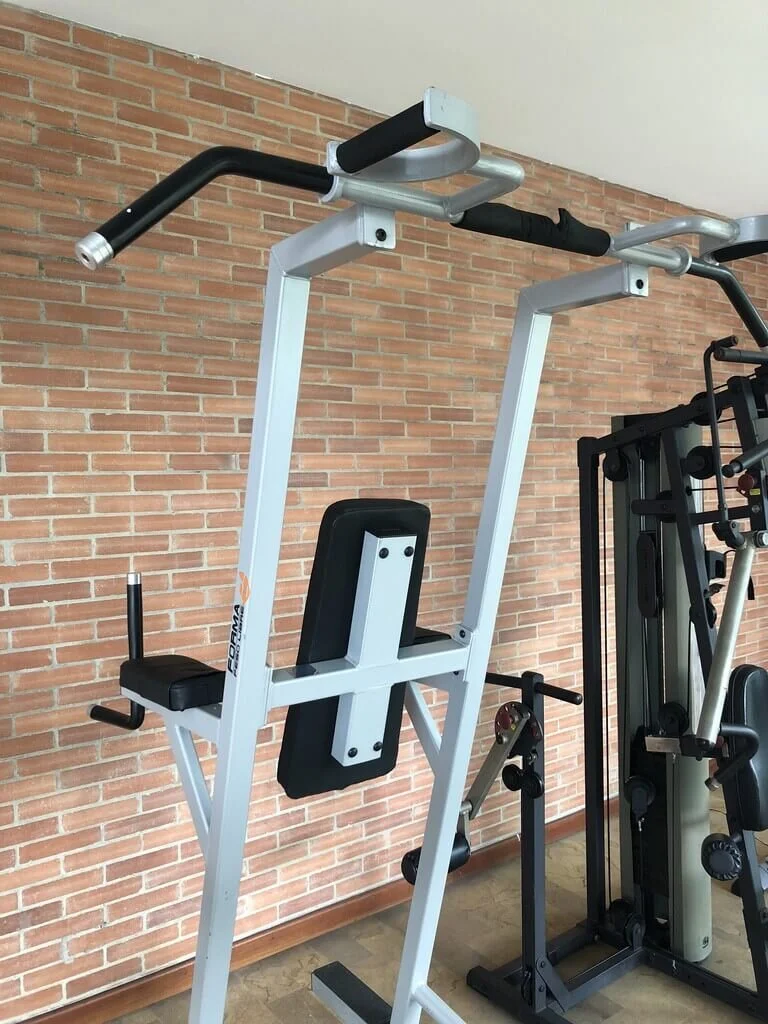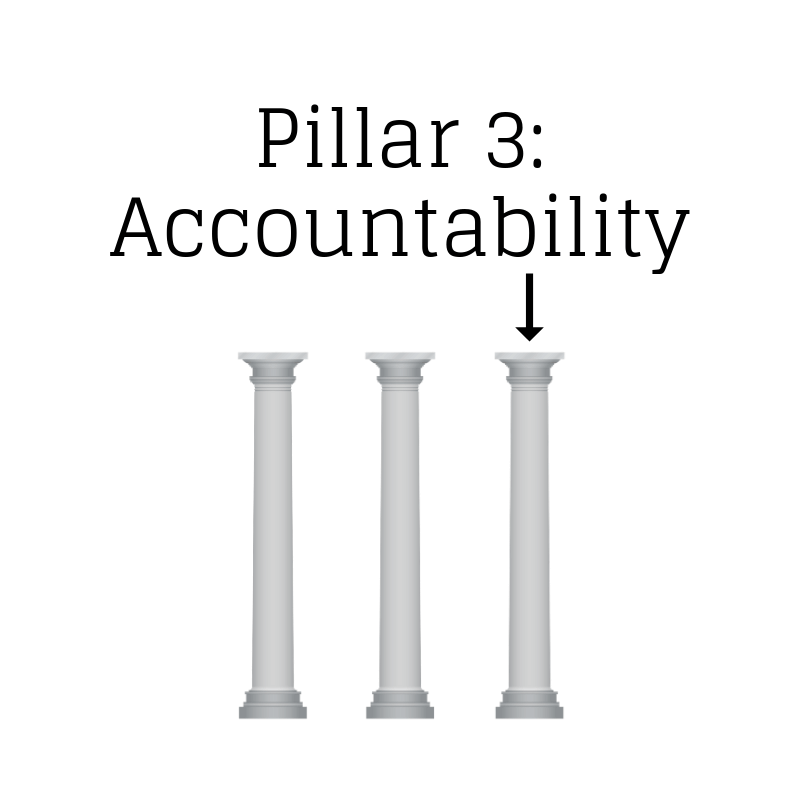How I Lost 25 lbs, 5% BF, and My Chest Hair in 100 Days While Traveling the World
I’ve been traveling internationally while working full time for just over a year now. I’ve been to 9 countries, and often spend about a month in each of them.
Travel is incredible.
It’s become the foundational priority of my life. It contributes more to my personal and professional growth than anything else. Time accelerates when I travel — the amount I’ve learned and experienced while traveling makes 1 year feel like 10.
Typically people travel for vacation, which is often one or two weeks at a time.
The mindset of a long-term traveler and a vacationer are different. I don’t think there’s a better example of this than with HEALTH, because a vacation mindset is quite different than normal life:
“Getting away from the grind for a week or two creates the perfect storm of justification for alcoholic binges, sugar rushes, skipped gym days, and the induction of laziness at epic proportions.”
I’ve seen the excuse again and again, and I’ve been 100% guilty of it myself.
And I think it’s OK to let go sometimes.
As long as it’s only for a few days. But then many of us have to muster up our willpower from depleted hormone stores to power through hangovers, like zombies. We chalk up the discomfort of a dreadful post-vacation Monday as the cost to play the game of life.
But what happens when you adopt serious, long-term, committed travel as a lifestyle — NOT a vacation?
It becomes impossible to constantly make the excuse of travel as justification for shitty health habits.
And, in my assessment, maintaining a healthy lifestyle is the most important adjustment an individual can make when committing to long-term travel. If you want to be healthy while traveling, you have to overcome every fathomable excuse programmed into your brain through years of societal conditioning.
It’s easy to fall back into “vacation mode,” but the individuals who succumb make their everyday life less functional. There are nuanced difficulties to finding a healthy routine when you travel to new locations frequently:
Easily accessible and healthy food options that don’t break the bank
A centrally located, reasonably priced short-term gym membership
People that share similar habits and support your healthy decisions
Solving my own health puzzle has been my primary focus over the past year. I consistently ask myself:
“How can I best institute healthy and sustainable habits through the rigors of constant international travel?”
It was initially difficult to transition my mindset, but I’ve found some answers that work for me. Through sharing what I’ve learned in my experiences, my goal is to enable you to apply some of these methods too.
The 100 Day Abs Competition
A recent challenge with some of my close friends further solidified the strategies outlined in this article. Sparked by a few humble egoists and some competitive fire, myself and 7 other friends wagered to see who could formulate the best abdominals in a 100 day time frame.
I love challenges, and my favorite number is 100 days. There’s so much you can accomplish in just over 3 months. We started at different levels of fitness, so a major factor for each person was the amount of progress made from the beginning to the end.
The same shirtless pic twice within the first two sections of the article? Bold move, I know.
Pic on the left: In California winter (December), right after my white ass took FULL advantage of Christmas & Thanksgiving at home with the fam and was eating everything. Pretty unflattering pic and not happy to be at that point so recently.
Pic on the right: Here in Medellin after a few months of hard work, some South America sun therapy, and a chest hair reduction.
Oh, and as for who won the competition?
I didn’t.
My homie Gabe Krebs took the crown, take a peek at his results:
Gabe calling me out on IG and then absolutely crushing it.
This challenge became a gateway to progress. Upon completion, I felt compelled to share my findings and peel back the curtain to my process. I want to share what worked and provide duplicable, actionable information. While the information I include is in the context of traveling, it doesn’t matter if you travel or not.
In fact, you’ll find many of these tactics are even easier to execute if you’re stationary. And, if you ever go on vacation or travel at all, these habits are sustainable while on the road. You don’t have to compromise your health to see the world.
My Three Pillars of Travel Fitness Success
When putting this information together, I broke down the components as building blocks for a healthy lifestyle integrated with perpetual travel. Each section includes tactics you can act on immediately. I’m proud of where I got using them over the 100 days. My intention is to continue progressing and experimenting with these and more to optimize my health.
The foundation of health, no matter how much you exercise, is your nutrition. In this section I’ll explain how I addressed nutritional challenges on the road with multiple approaches.
The most common obstacles I face while traveling with nutrition are access and temptation.
Access to healthy, affordable food in different locations can be tough, especially when I don’t know the area well. Temptation is rampant. When immersed in unchartered territory, it’s enticing to want to eat at all the fascinating restaurants, quaint coffee shops, and intriguing food carts I pass on morning strolls.
But with my budget and health goals, I prioritize other things than eating out. I occasionally go to restaurants, but try to mostly eat home cooked or pre-prepared meals.
If I eat out, I’ll sometimes implement a trick I learned from my friend Megan Benedict — which is to look at a restaurant’s menu beforehand, and pre-select my meal. That way I already made a conscious choice for myself and I don’t buckle in the moment and make an unhealthy selection.
The Power of Omission
What you put IN your body and and oftentimes what you DON’T put in your body is crucial to achieving results and often the causation of how you feel.
It’s concerning how much humans mindlessly consume. Widespread propaganda and targeted marketing campaigns (especially noticed as an American) suppress us into cyclical consumption. It creates and celebrates behavioral patterns starting at an extremely young age.
Think about it… most human congregations are centered around the act of consumption. A few simple examples, but not limited to:
Dating (lets grab dinner)
Going Out (lets grab drinks)
Work Meeting (lets grab coffee)
The compound effect of these patterns of consumption, if not moderated, can lead to unintended consequences.
“We get accustomed to spontaneous after work happy hours, unconscious retail therapy, and nonchalant $4-$7 “filler” purchases (often in the form of coffees and snacks we don’t actually need or even want).”
These become norms, and we are often too close to our own activity to realize how much these small actions lead to larger results — not only health wise, but monetarily.
Simply becoming aware of these patterns can allow you to start disrupting them.
I began enacting a rule called, “The Power of Omission.”
I started tracking all the seemingly minuscule things I would consume during the day. I linked all my bank accounts to Mint.com and went through my transactions daily. I wanted to see the patterns — both nutritionally and monetarily. In years past I’ve admittedly had little awareness of these things. But this type of blissful ignorance isn’t cute.
My focus shifted to what and where I could start omitting:
Fasting
Fasting is intentional abstention of food and/or beverages. There are multiple ways to fast. For the past few years I’ve been experimenting with intermittent fasting, and generally follow a 16:8 schedule (example in the graphic below), where I’ll only eat my meals between 11 am-7 pm for 4–5 days a week.
Graphic from: Intermittent Fasting Explained by Theo Brenner-Roach
Within this 100 day challenge I also started instituting full 24hr+ fasts, where I wouldn’t eat from Saturday night around 7pm to Monday morning around 8am. While fasting for the entirety of Sunday I realized those were my most productive days. When I give my body a break from digestion, I feel lighter and I tend to have more clarity. It’s also a huge test of willpower.
The mental fortitude I’ve built from not eating one day a week has been immense. I’m used to eating at any sign of hunger, and I’ve also been a binge eater most of my life — going on streaks of eating thousands of calories in one sitting after the smallest triggers. I learned I need to be OK with hunger (and cravings). I’ve become mentally stronger and built a higher tolerance of willpower to say “no” to myself.
Science also backs up the benefits, and according to Healthline, fasting:
Promotes blood sugar control by reducing insulin resistance
Promotes better health by fighting inflammation
May enhance heart health by improving blood pressure, triglycerides, and cholesterol levels
May boost brain function and prevent neurodegenerative disorders
Aids weight loss by limiting calorie intake and boosting metabolism
Increases growth hormone secretion, which is vital for growth, metabolism, weight loss and muscle strength
Could delay aging and extend longevity
May aid in cancer prevention and increase the effectiveness of chemotherapy
Processed/Added Sugars
During the last 30 days of the 100 day challenge, my friend Gabe and I decided to cut out processed and added sugar from our diets. It was extremely difficult and I realized how addicted I am to sugar. It’s inescapable and hiding in *almost* everything. In the early stages of deciding to eliminate sugar, I consulted Mark Metry, the host of Humans 2.0, a top 100 podcast. He has an episode that talks about quitting sugar that helped settle some of my concerns, expectations, and preparation.
It wasn’t about being perfect, because there were multiple occasions where I slipped up. But I didn’t let one small collapse define my failure or success. I made the conscious decision to power through and not let it happen again that day. I immediately saw the results from cutting out sugar. This tactic was probably the most impactful out of them all.
Even if you aren’t going to fully exclude processed sugar from your diet, a good rule of thumb is to at least eliminate drinking sugar. Cut out juice and soda and stick to water as much as possible. Hydration can be key in keeping hunger at bay too. You’ll notice differences quickly in your ability to lose weight as well as a host of other benefits.
Refined/White Carbs
White carbs are sticky. Many people eat WAY too many refined carbs, leading to obesity and other diseases. Taking them out can be similarly as effective as cutting out sugar because the body converts these types of foods into sugar.
I bloat instantaneously when I eat white carbs, especially bread. And g’damn it, I LOVE bread. But I knew by eradicating most white carbs from my diet I would see positive changes in my body. I tried this a few years ago when I was on the Slo-Carb diet, made famous in Tim Ferriss’ 4-Hour Body book.
These pictures are 8 months apart in 2016, when I implemented the Slo-Carb diet.
When I instituted his suggestions in 2016 I saw MASSIVE results: a decrease of ~15% BF and 40 lbs in 8 months. Many principles used then were relevant this time around too. It’s funny how health works. We can go through ebbs and flows of success, failure, and fluctuation. But, simply put, health is a lifelong practice. There is no finish line, and if you let yourself go, you’ll find yourself falling back into the same low places.
Alcohol & Coffee
I’ve been without alcohol and coffee for over 250 days, and seriously, they are two things I never thought I couldn’t live without. I quit alcohol last August for many reasons. I got to a stage in my life where I no longer enjoyed drinking:
It didn’t feel good in my body and hangovers would last more than a day, plus I noticed increased anxiety and depression
I didn’t find fulfillment in typical activities involving drinking anymore (bars, partying, clubbing)
Historically I’ve had difficulties moderating my alcohol consumption (binging), and I was tired of the self-shame and hate I carried about myself from how I acted when I was drunk
I realized alcohol did not provide any benefit in my life. Cutting it out was the best decision I’ve ever made. But, as a result I discovered I soon replaced my cravings and habitual consumption patterns of alcohol with coffee. I don’t inherently think there’s anything wrong with coffee, but it is a substance, and any substance can be abused.
I started feeling like I needed coffee to get through my day. I would drink it at night while out at dinner or bars. While those around me drank alcoholic beverages, I’d be on my 4th or 5th coffee at 11pm. One day I even drank 10 cups of coffee. I felt like crawling through a stone wall with my fingernails just long enough to distract myself from the discomfort and apprehension of a possible caffeine overdose. Not only was coffee messing up my sleep, but I noticed constant, jittery anxiety. In many cases my consumption is easier at 0 than trying to moderate. I started using caffeine alternatives, especially matcha tea (shout out Tenzo Tea).
Automating Nutritional Decisions
Guys like Steve Jobs or Mark Zuckerberg wear the same thing every day. The principle is the same with eating — decision fatigue wastes precious brainpower. The fewer decisions you delegate to making at the moment, the better. When the average person already makes 35,000 decisions each day, why make eating the right things a decision?
Personally, if I’m making decisions about food every day, I’m going to make poor ones. Not only because my willpower is worn down from thousands of other micro contemplations, but because I’m hungry. I’m not me when I’m hungry.
Although I definitely don’t advise eating a Snickers.
The more you automate in the process of eating healthy, the less you’ll succumb to bad choices. It starts and ends with the environment you set up for yourself.
“By failing to prepare, you’re preparing to fail.”
And with food, you also need to know all the places you may fail. Avoid situations where the temptation will override willpower. Make it as easy as possible to stick to it.
Make it Financially Stupid to Eat Bad
Money is a motivator for me. When I invest $$ into food I stifle my desire and propensity to spend more money on other choices. This makes eating out harder to justify. Not only would I feel stupid if I’ve already paid for food and I continue to spend money, but I don’t have the budget to do it. Try anchoring your commitment to healthy food in advance with your hard earned cash.
Take it Out of Your Hands
You can hire a chef or a nutritionist to make dietary decisions for you. At the moment I live in Medellin, Colombia. My roommate and I are able to afford a full time chef to cook our meals. It doesn’t hurt we’re both trying to learn Spanish too, and Kevin (our chef) speaks English and Spanish fluently. The cost of living here is drastically less than the US, so you may not have the same ability or budget — but it’s worth looking into a nutritionist or meal plans to outline what you eat each day. Taking the decision out of your hands and having others cook for you can be a huge weight lifted from your list of responsibilities. This leads me into the next section…
Comida de Kevin, our Colombian chef. His food is amazing despite the fact I often douse it in Sriracha after he takes pictures of it.
Increase Convenience
Ever get tired of long trips to the grocery store, carrying your food in, prepping, and cooking? Consider ordering pre-prepared food delivery. This has become a wildly popular business model. There are national (USA) and local companies who send meals to your doorstep (both pre-prepared and just ingredients so you can cook it). A lot of the national companies have promotions for free meals.
My recommendation for trying these services if you’re in the US: try as many of them as you can for their “first time customer” promotions to take advantage of free meals and discounts until you find one you like. Usually if you sign up for their mailing list you’ll get a certain % off, and when you try to cancel they’ll often run a promotion to get you to stay.
Although the national services can be great, I prefer local small businesses because the food is typically fresher and it preserves the money in the community. When traveling I don’t have a consistent address, nor is there much availability of large scale national companies in other countries (that I’ve seen). During my time in Latin America over the past 5 months I’ve found multiple local, fully prepped food services in every country I’ve been to. They deliver fresh meals to my door and usually have a variety of plans (Keto, Weight Loss, Vegetarian, etc).
If I’m able to find these types of services in Mexico, Peru, Chile, and Colombia, my guess is that most people can find one near them. A simple Google search will reveal the companies (especially in large metro areas) who are competing for your business. Search: “Meal prep in [city name]” to see what options are near you. If the cost of those meals seem expensive, consider the expense of grocery shopping and cooking:
The hours spent going to and from the store
Time walking around shopping in the store and the brain capacity to select the right items (not to mention fighting temptation to avoid the wrong ones, and all the point of sale purchases that allure you)
Gas and depreciation on your car (or public transit or taxi costs) if you can’t walk there
Time prepping, cooking, and storing the food
After factoring in these costs, and utilizing the time I get back, it’s worth it for me to buy fully prepped meals ahead of time.
Put in the Upfront Work
For those that enjoy spending time cooking, meal prepping is a good option too. I, personally, am not a fan of meal prepping. Even though I like to cook, the amount of time required to invest in meal prep is difficult for me to justify. But if it truly gives you satisfaction and you’re highly particular about your ingredients, then going to the store and shopping yourself might be the right move.
Many grocery stores are now providing online shopping and delivery to save you time, and some of the national food service delivery plans will deliver ingredients rather than fully prepped meals — so you can get your cooking fix in but still save some time. In other countries there are apps like Rappi who provide inexpensive grocery delivery service. There are tons of great meal prepping guides and suggestions out there on how to do it.
Make Healthy Foods Available On the Go
Map out your schedule. Think about when in your day you’re going to be hungry, and what challenges you might face in finding healthy food. Predicting these critical moments in your day and how you’re going to mitigate risk of unhealthy choices is paramount to your success. Always make the decision before the moment, not in the moment.
Mango con Granadilla is a DELICIOUS mid-day snack. Fruit in South America is next level.
I recommend keeping meals and/or healthy snacks with you at all times for when you might be in a pinch. For example, if I know I’m going to be traveling or in between meetings and unable to cook a meal at home, I’ll bring a container of assorted fruits, carrots, chopped cucumbers, or snap peas to crunch on to subside my hunger. I’ll always have a refillable, sustainable water container with me too. If I stay hydrated throughout the day, I find I’m less hungry. One rule I’ve tried: every time I get up to go to the bathroom I have to fill my water bottle.
When you’re in difficult situations for finding food, it can also be a good opportunity to just skip a meal. I’m not advocating anorexia. I am advocating for individuals who have a healthy relationship with food and their body to be OK with omitting food sometimes (see the Power of Omission above, but always consult a medical professional — something I’m not). In prehistoric times humans did not always “need” to eat as much as we claim we need to in modern society.
Now that we’ve covered the bulkiest section, nutrition, I want to move onto a secondary and crucial component of my process: exercise. Incorporating movement into my daily routine, especially in the morning, creates a ripple effect throughout my day of momentum and energy. While traveling it may seem obvious, but one thing some people overlook is actually packing their workout clothes and shoes. Simply having the right equipment is an important first step to building motivation. Try setting aside your workout clothes the night before if you work out in the mornings. Below are other strategies I also use to make it easy to structure exercise into my routine during travel.
Walk Everywhere
NOT having a car is a blessing. When I left the US over a year ago I sold my car and it was liberating. When traveling, walking around cities is one of the most entertaining and enlightening experiences. You can smell the foreign plants, witness the nuances of street exchanges, hear the buses whoosh by, and learn how to navigate the neighborhood like a local. The current co-working space I go to is about a mile away and Medellin has plenty of hills. I see it as a perfect opportunity to throw on an audiobook, podcast, or music, and get a brisk walk in. If any walk is under 2 miles and in a safe area, I’ll walk it, by rule. There’s no reason to spend money on a taxi or emit more carbon into the atmosphere when my legs work perfectly fine.
Local Gyms
Most of my travel has been confined to 1–3 months in a city at a time, which generally makes it difficult to obtain a gym membership. Many gyms have upfront time commitments, initiation fees, and some don’t allow foreigners without local identification (I’m looking at you, Santiago Chile).
Maybe this is why they don’t let foreigners in…
Some gyms do allow short term memberships. Do a search online, check reviews, and see what pops up. Find local universities as sometimes they offer access to non-students. It can be beneficial to walk in to a gym and ask what their policy is. Many gyms have a free first day which you can take advantage of (if there are options, try out a few instead of settling for the first one).
And if you’re part of any local communities, especially a co-working space, inquire to see if they have any partnerships with local gyms. I try to find a gym with classes because I like having someone do the thinking for me (see nutrition section above if you didn’t figure that out already). Plus being in a group setting provides motivation. If I’m able to take away the decision of what type of exercise or workout to do, and I know I’ll still get a good workout, I’m happy.
Local Gym Travel Tip: Be sure to clarify when you need to cancel so you’re not billed additional months or get stuck in a contract. I’ve been in multiple situations where language barriers have led to complete misunderstandings of membership policies, and thus had to fumble through conversations or find translators to get my money refunded.
Hotel Gyms
I don’t usually stay at hotels. I prefer Airbnb’s and sometimes get lodging through my company, Remote Year. However, many hotels have basic gyms, and can be a good option for traveling and working out. Even if you aren’t staying at a hotel, you might be able to cut a short term deal to only use their gym area. Because hotels are accustomed to hosting foreigners and vacationers, they sometimes offer spa and gym access separate from guest access (see more in the Groupon section).
AirBnB Gyms
Depending on where you stay you can make your gym and home one in the same. I LOVE the personalization and uniqueness of having my own apartment in a city. It makes me feel like I’m getting more out of the experience, equips me with a homey atmosphere to work from, and provides comfort that some hotels don’t have. Whenever I’m searching an AirBnB for a new stay, I start by filtering: “Facilities > Gym.” While this might limit results and be more expensive, I know for a fact if I have a gym in my building, my life is better. I’m happier, healthier, and I can sneak way for a few sets of pull-ups in between calls if I’m feeling low on energy.
Gimnasio de AirBnB.
Outdoor Gyms
Finding a good outdoor gym is like finding money in old jean pockets. You’re not actually any richer because it was there the whole time… but you feel like you just scored. Knowing you don’t have to pay for a membership to get a good workout is great, and in luminous weather, what’s better than an outdoor workout!? I usually keep my eyes peeled for pull up and dip bars strategically located in city parks, walkways, and public squares. If you walk by one, make sure to save the pin on your maps (Google and Apple Maps both have the functionality). If you don’t find any while walking around, a quick Google search, Outdoorgyms.co, or a FourSquare “Outdoor Gym” search might work.
Groupon
I’m a big fan of Groupon, especially since they’re in all the Latin America cities I’ve been traveling to recently. Based on their website linked here, they operate in 48 countries and counting. Check the list to see if they are in the country/city you’re in at the moment. The key here is to filter down from the “Local” section and click “Health & Fitness Deals.”
You’ll find out if any local options are available. I’ve found many short term gym offers at low prices on Groupon. There’s usually spa, massage, and immersive local activities available too.
Organized Sports
I love basketball. I’ve been playing for years and bring my shoes with me to every country. In each city I travel to I search out local groups on Facebook, like the Medellin Basketball Association, find local courts via Google search, and by walking around. If you play a sport and want to continue while traveling, see if there are games locally. You can check Facebook groups, Meetup, or local co-working space bulletin boards. It’s especially fun to play with locals. If you’re looking for an additional challenge, play a local sport you’re not great at or don’t know how to play. I’ve been daring enough to play fútbol once (I swear I have two left feet), and although I embarrassed myself, it was a lot of fun.
Just Run Around
If you’re in a safe neighborhood, considering going for a run. I HATED running for years before I realized I was missing out on a huge opportunity. When I started embracing running as a way to assimilate, similar to walking around, I started absorbing more of the culture. You find little nooks and crannies, mom and pop shops, unique cafes, and rarities you might miss if you only travel the city by automobile. By re-framing my reason for running in my mind it was no longer boring. It became an exciting adventure each time I stepped out of the house. Since adopting that attitude I’ve gone on to run 2 international marathons and a handful of half marathons.
Get Out in Nature
If you’re like me, your bare feet touch the soil once every few months. I’m by definition NOT an outdoorsy person. Don’t get me wrong, I love a good hike. I’m just the kind of guy who also loves immediately heading back to a warm shower and crawling into a king bed afterward. If you found me camping it’s more likely that it happened by mistake than by hobby.
Lenny Pepperbottoms has more swag than I when it comes to Nature.
Regardless, I always enjoy checking out local scenery in the form of hikes, hills, and landmarks, because it provides an opportunity to not only see something cool, but to introduce dynamic movement to your body. Ask a local or conduct a Google search to see if there’s anything close and take a trip.
Use What Yo’ Momma Gave Ya
Often overlooked is the power of a good body-weight workout. There are a myriad of movements and exercises you can do with just a floor. Add a chair and now you’ve got a party. Some of my favorite body-weight movements:
Jump Squats
Push Ups
Lunges
Tricep Dips (on chair)
Sit Ups (legs hanging over bed)
Not only are these easy to do because there’s no set up time, but they can also increase your range of motion and functional strength.
I use an app called Seconds to pre-populate HIIT and Tabata workouts. I segment them by equipment available and focus area on my body. There’s tons of fitness apps, like BodyBuilding.com that provide workouts for you so you don’t have to think about it. Again, take away as many decisions as possible and you’ll notice a BIG difference in your ability to execute!
All the other info in this article is great. But info is just info, until you use it. The longevity of your health, whether you travel or don’t travel, is equal to your ability to be consistent. There’s no better way to take action than to surround yourself with other people who will hold you accountable to your actions.
“When we started the 100-day challenge I referred to at the beginning of this article, the lifeblood of the rivalry was healthy competition and support we fostered along the path of achieving our own individual greatness.”
We genuinely care about each other. We provided each other a platform to share failures, successes, and observations along the way. It makes it important when you have something on the line, even if it’s just pride and your peers’ opinions of you.
Our accountability started with a good group of guys who were all pushing each other and had similar ambitions. All you really need is one other person who will hold you accountable. It will always be better if you can be in proximity of the other person, but remote check-ins work too. If you don’t have a friend or acquaintance who fits the bill, HIRE someone — a coach, a mentor, or a hard ass who will hold you to your word and check on you at least each week (if not each day).
When working with an accountability partner (s), a coach or a mentor, you need to play an active role in the relationship. It’s not just up to them to check on you, it’s your responsibility to be proactive in overcoming your own barriers and asking for support when needed. There’s many things you should consider in your agreement with each other.
Start with Your Necessary Daily Habits
The larger goals we strive to achieve are great, but the process is what matters. What are the micro decisions that compound to help you achieve the greater goal? What are the daily, nitty, gritty details. Write these out. What habits can you be accountable to doing every single day, and start small with what you know you can actually stick to. It can be highly discouraging if you choose unreasonable initial quantities for your daily routines. When you start small you can build momentum and always add as you go.
Take into account the obstacles that might prevent you from completing your daily habits, and create “if, then statements.” An if then statement explicitly outlines how you’ll act in a particular situation. For example, “If I see food I’m craving that’s unhealthy, and I feel tempted to eat it, then I will take a picture of it and send it to Gabe.” That’s one of my real “if, then” statements. Borrow it if you want. It was my quirky way of “consuming” the food (albeit through my phone), and getting it out of my head.
Sign Contracts
Once you know the individual habits each of you are committing to, sign it in stone. Well, not literally in stone. But consider drafting up a simple contract. Set the terms of the contract starting with what you’re aiming to accomplish, potential obstacles, your daily commitments, the time and date parameters, who is helping to hold you accountable, and either a punishment for breaking it, or a reward for completing it.
Depending on the individual, a negative or positive motivation will work better. Once you’ve written something out, it becomes real! Following our first challenge, Gabe and I are continuing our sugar challenge, and put it in writing here. If we don’t adhere to the contract we are bound to donate to a political campaign that we despise.
Have Something to Look Forward To
I always appreciate having something to look forward to that builds motivation into my life. These events act as commitment devices —which according to Wikipedia is: a way to give yourself a reward or punishment to make an empty promise stronger and believable. I tie the event, trip, or festivity to the results I’m looking for.
For example: I’ll plan a beach trip a month or two out of being “beach ready.”
Knowing a trip is coming up, I’ll use it as leverage to push myself to get in great shape for the inevitable pictures we are going to be taking. Plus, I want to feel fucking good walking down the beach. For many years of my life I was ashamed to take my shirt off because I was overweight, and now it’s become a source of pride. Find your reasons and don’t be ashamed if they are a little egotistical. If not a beach trip, get creative in what will motivate you. Consistently planning allows me to be consistently motivated, there will forever be a next ‘something’ to work toward.
Complete Mini-Challenges Along the Way
Similar to having something to look forward to, it’s also fun to institute milestones with complementary ‘mini challenges’ to your larger goals or challenges. During our 100 day challenge, we established a 30 day NO processed sugar and bread challenge during the last leg of the 100 days. We also introduced 24+ hr fasts one day a week every Sunday, as mentioned in the ‘fasting’ section above. Races and other physical contests are great too. I signed up and completed a half marathon. It became motivation to run each morning and train my endurance — resulting in congruent, supplementary actions that contributed to my progress.
After completing the Corre Mi Tierra half marathon in Medellin.
Be Nice to Yourself
Along the path of bettering yourself, especially during challenges, you’re bound to screw up. If you fuck up for a day, let it go. Get back on the horse immediately and don’t wallow in your own self-guilt. Now, I’m not condoning letting yourself off the hook completely. But here’s the thing… beating yourself to a pulp doesn’t allow you to move forward.
You don’t have to give yourself excuses when you blunder, but we all need to be kind and loving to ourselves. We need to remember: we’re human. Confide in the group of folks or the buddy you have keeping you accountable and ask for a healthy push to get to where you want to go. Learn from the moments where you didn’t perform at your peak, and take the steps to prevent it the next time it comes up. Go back to one of the first concepts I mentioned — setting up your environment for success, and make adjustments.
Call To Action
I hope you found this resource useful. These methods have helped me improve my life in every facet. My call to action for you is to take at least one thing from these sections and implement it right now. Whether you’re a nomad, occasional traveler, or fully stationary, these principles are truly universal.
Write me below.
Leave me a comment and let me know what I missed that you do. Let me know what kind of challenges you’re looking to introduce in your life. Maybe we can do one together.
And if you read this far out of curiosity of when I was going to address my chest hair — well, no magic. I trimmed it off to see my abs better. Hope that was worth reading everything else.
Until next time… keep wandering, you’re NOT lost.
Want more?
Subscribe to my Youtube channel for all things remote, link below 👇

